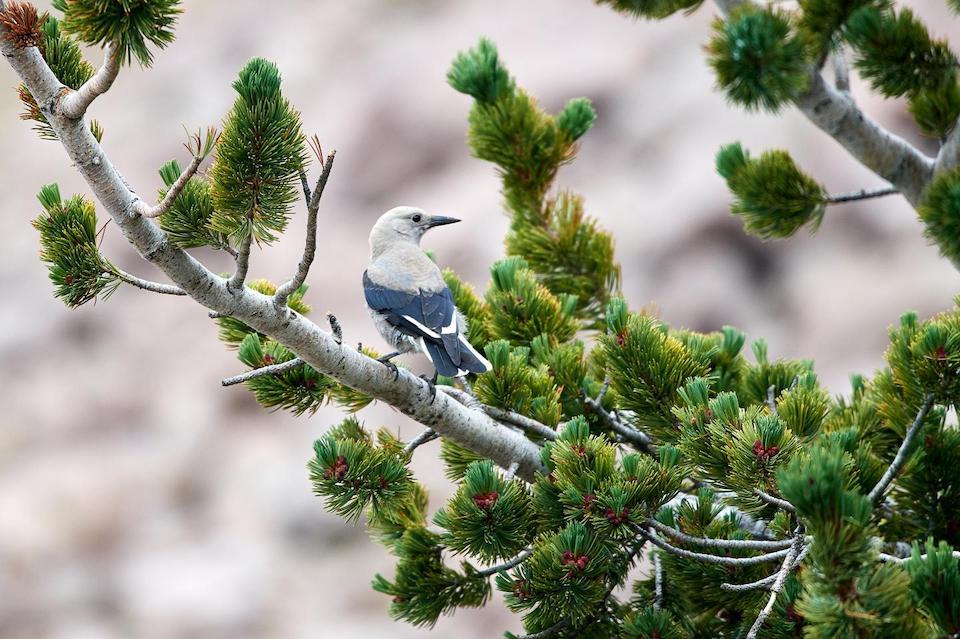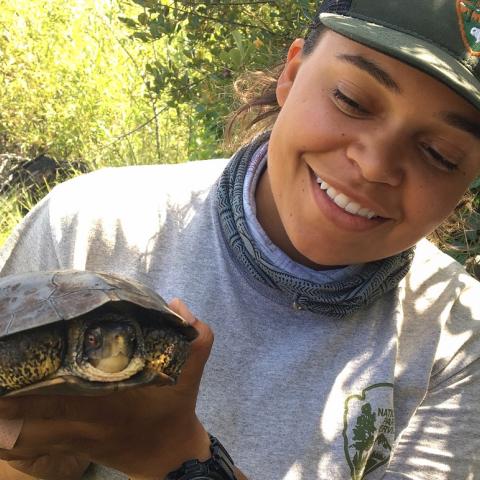
A Clark's Nutcracker perches in a whitebark pine/Frank D. Lospalluto/Flickr. (CC BY-NC-ND 2.0)
Clark's Nutcrackers are ubiquitous to many Western national parks. When you set up camp in the backcountry they are quick to arrive, and they're not shy about begging for a treat or even stealing one. But they could vanish from some of those park settings if whitebark pines vanish, according to new research. And without the birds, new stands of whitebark pine might never get planted.
The nutcrackers, a member of the crow family, feast on whitebark pine seeds, and have a habit of stashing many seeds -- some say thousands -- for later use. Of course, sometimes the birds don't recall where they buried the seeds, which then can germinate and sprout if they're not discovered by squirrels, chipmunks, or even grizzly bears.
While the iconic pine depends heavily on nutcrackers for seed dispersal and germination, the nutcracker merely prefers the whitebark pine's seeds, notes a release promoting the study, which appeared Wednesday in the journal PLOS ONE. If whitebark pine seeds aren't available or abundant, the nutcrackers will fly off and find another food source, adds the release.
That study suggests that the inequality in the pine-nutcracker "mutualism" may make this partnership vulnerable when the populations of one of the partners declines. Scientists from The Institute for Bird Populations, the National Park Service, and the Northern Rockies Conservation Cooperative found that the mutualistic relationship between whitebark pine and Clark's Nutcrackers may be threatened by local declines in the tree's population.
The researchers used data from separate tree and bird monitoring programs in five national parks to examine the relationship between Clark's Nutcracker and whitebark pine in each park. The parks included two in the Pacific Northwest: Mount Rainier and North Cascades, and three in central California: Yosemite, Kings Canyon and Sequoia. In the Pacific Northwest, whitebark pine populations have been decimated by a fungal disease called blister rust. But the disease is not yet widespread in the central California region.
"We observed a dramatic decline in Clark's Nutcracker within Mount Rainier National Park, where the number of birds counted in the park fell steadily to zero over a decade, and those losses appeared to track an observed decline in healthy whitebark pine," says the lead author of the paper Dr. Chris Ray, a research ecologist with The Institute for Bird Populations.
While the study did not determine whether the decline in whitebark pine caused the nutcrackers to leave, the lack of nutcrackers, regardless of the cause, has important consequences for the remaining whitebark pine, said the researchers.
"There might be other reasons why we no longer detect many nutcrackers at Mount Rainier during the summer," explains Ray, "but a total loss of nutcrackers would clearly disrupt the mutualism there, curtailing local seed dispersal and germination of whitebark."
Whitebark pine health is designated by the National Park Service as a "vital sign" of the subalpine ecosystems where it grows because it is a keystone species. This means that it is critical to the ecosystems' ecological function, supporting many other plants and animals that live there and influencing processes like snow retention and spring run-off. Declines in whitebark pine populations have been attributed to an interacting set of factors including blister rust disease, mountain pine beetle infestations and climate change.
Park managers are very concerned about the dramatic declines in whitebark pine in recent decades and what they mean for the ecosystems the pine calls home, says National Park Service ecologist and co-author of the study Dr. Jonathan Nesmith.
"These declines have been so severe that whitebark pine is a candidate species for listing under the Endangered Species Act," said Nesmith. "By understanding what is going on with whitebark pine we can better understand what is happening more broadly in the high elevation systems where they grow and how they might be changing due to climate change and other stressors."
The researchers note that in North Cascades National Park, where whitebark pine populations have also declined, Clark's Nutcracker populations "fluctuated wildly" rather than declining to zero as in Mount Rainier National Park. It is possible that nutcrackers, who routinely fly up to 19 miles in a day, may be taking advantage of whitebark pines outside the park boundaries.
The nutcrackers may also be shifting their foraging patterns and seeking other tree species. In the central California parks, where whitebark pine populations are still relatively healthy, Clark's nutcrackers were not always associated with whitebark pine.
"In Sequoia and Kings Canyon National Parks, nutcrackers were often detected in areas where foxtail pine appeared more common than whitebark," says Ray. "These results suggest that nutcrackers can leave areas where whitebark pine is in decline and seek resources elsewhere, which might mean that declining seed dispersal should be added to the list of current threats to whitebark."
The mathematical model developed by the researchers to examine the association between Clark's Nutcrackers and whitebark pine integrates data from two completely separate monitoring programs in these five national parks, one focused on birds and another focused on subalpine trees. This largescale approach yielded findings that would not have been obtainable from either program alone, or from monitoring in just a single park.
The model can now be used to study the nutcracker-whitebark mutualism further, as more data become available, and perhaps improve monitoring of the bird and the pine. From Ray's perspective, this may be the most important implication of the study: "During the process of developing this model we identified ways that these monitoring programs might expand to help answer questions relevant to the management of these species."




 Support Essential Coverage of Essential Places
Support Essential Coverage of Essential Places






